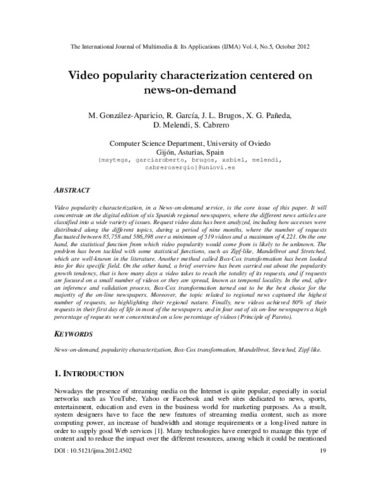Video popularity characterization centered on news-on-demand
Palabra(s) clave:
News-on-demand
Popularity characterization
Box-Cox transformation
Mandelbrot
Stretched
Zipf-like
Fecha de publicación:
Editorial:
Academy & Industry Research Collaboration Center (AIRCC)
Versión del editor:
Citación:
Descripción física:
Resumen:
Video popularity characterization, in a News-on-demand service, is the core issue of this paper. It will concentrate on the digital edition of six Spanish regional newspapers, where the different news articles are classified into a wide variety of issues. Request video data has been analyzed, including how accesses were distributed along the different topics, during a period of nine months, where the number of requests fluctuated between 85,758 and 586,398 over a minimum of 519 videos and a maximum of 4,221. On the one hand, the statistical function from which video popularity would come from is likely to be unknown. The problem has been tackled with some statistical functions, such as Zipf-like, Mandelbrot and Stretched, which are well-known in the literature. Another method called Box-Cox transformation has been looked into for this specific field. On the other hand, a brief overview has been carried out about the popularity growth tendency, that is how many days a video takes to reach the totality of its requests, and if requests are focused on a small number of videos or they are spread, known as temporal locality. In the end, after an inference and validation process, Box-Cox transformation turned out to be the best choice for the majority of the on-line newspapers. Moreover, the topic related to regional news captured the highest number of requests, so highlighting their regional nature. Finally, new videos achieved 80% of their requests in their first day of life in most of the newspapers, and in four out of six on-line newspapers a high percentage of requests were concentrated on a low percentage of videos (Principle of Pareto)
Video popularity characterization, in a News-on-demand service, is the core issue of this paper. It will concentrate on the digital edition of six Spanish regional newspapers, where the different news articles are classified into a wide variety of issues. Request video data has been analyzed, including how accesses were distributed along the different topics, during a period of nine months, where the number of requests fluctuated between 85,758 and 586,398 over a minimum of 519 videos and a maximum of 4,221. On the one hand, the statistical function from which video popularity would come from is likely to be unknown. The problem has been tackled with some statistical functions, such as Zipf-like, Mandelbrot and Stretched, which are well-known in the literature. Another method called Box-Cox transformation has been looked into for this specific field. On the other hand, a brief overview has been carried out about the popularity growth tendency, that is how many days a video takes to reach the totality of its requests, and if requests are focused on a small number of videos or they are spread, known as temporal locality. In the end, after an inference and validation process, Box-Cox transformation turned out to be the best choice for the majority of the on-line newspapers. Moreover, the topic related to regional news captured the highest number of requests, so highlighting their regional nature. Finally, new videos achieved 80% of their requests in their first day of life in most of the newspapers, and in four out of six on-line newspapers a high percentage of requests were concentrated on a low percentage of videos (Principle of Pareto)
ISSN:
Colecciones
- Artículos [37546]
- Informática [875]
Ficheros en el ítem





